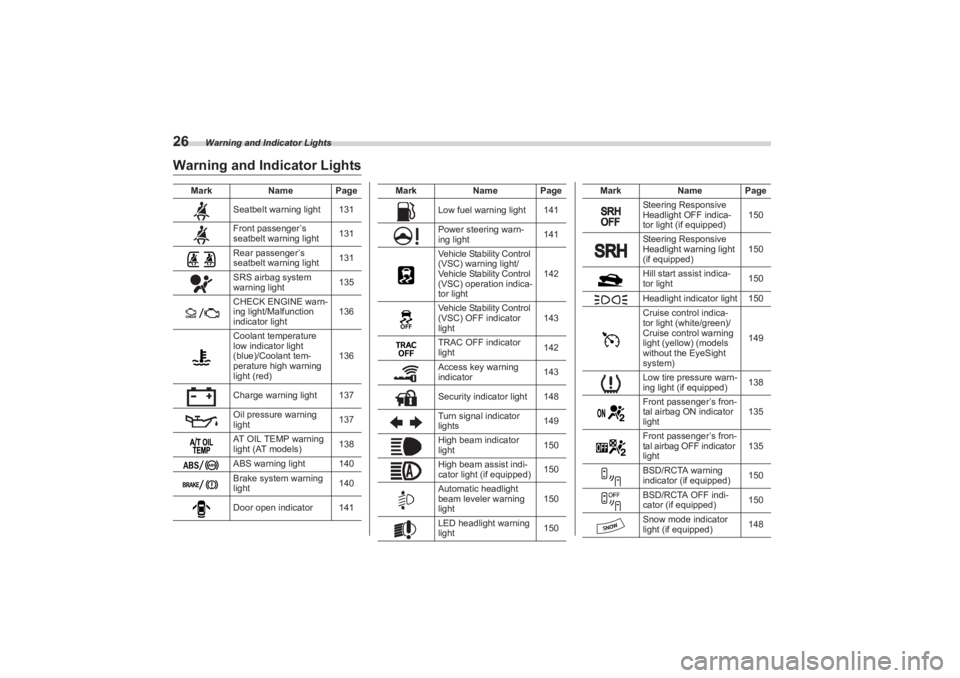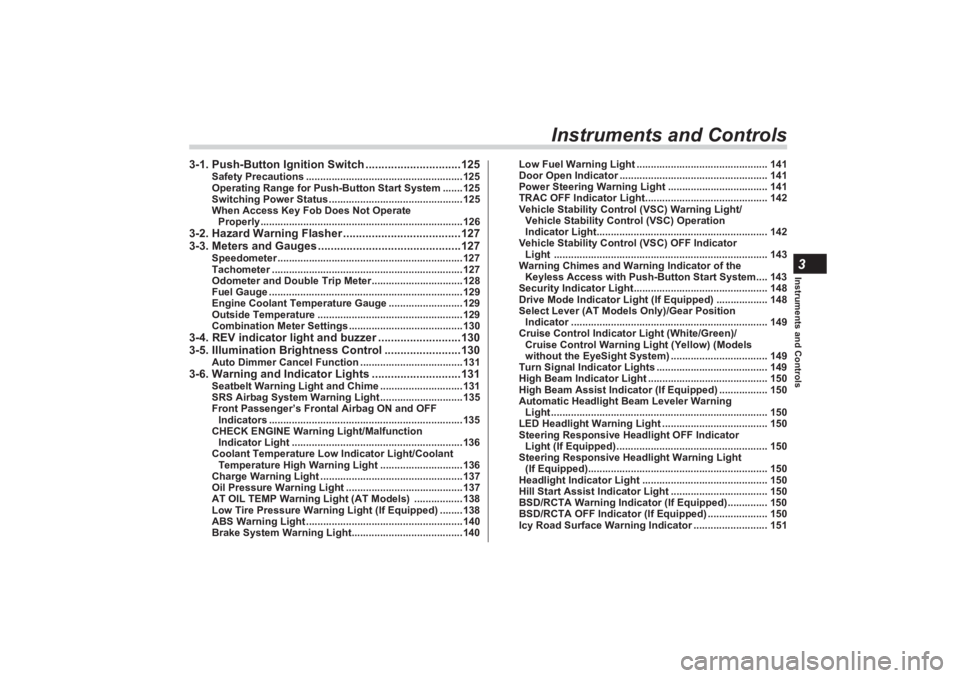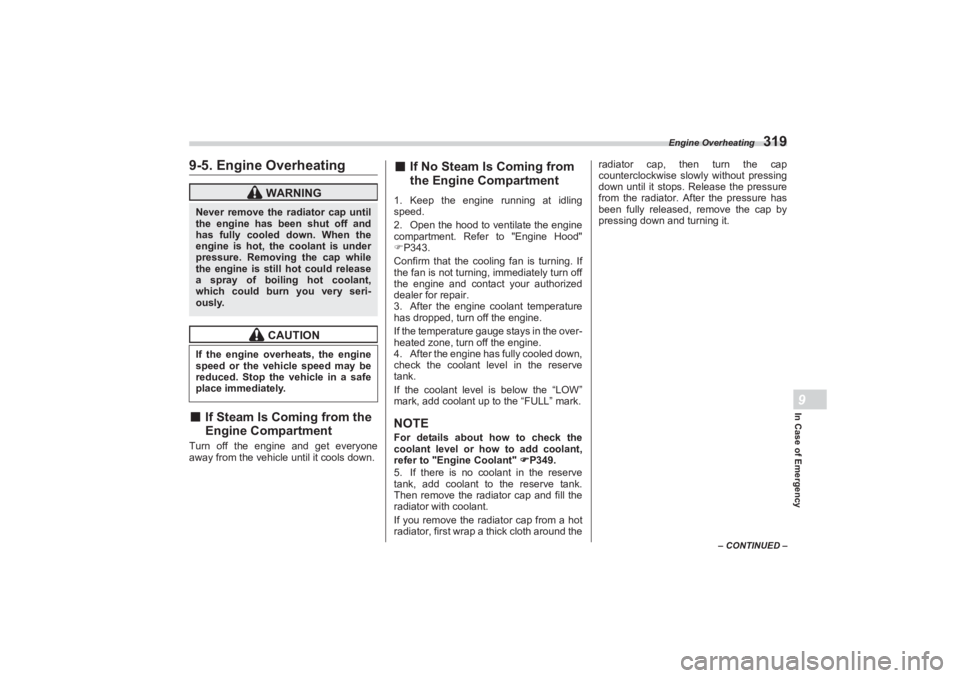2023 SUBARU BRZ coolant level
[x] Cancel search: coolant levelPage 32 of 432

Warning and Indicator Lights
26
MarkName Page
Seatbelt warning light 131
Front passenger’s
seatbelt warning light 131
Rear passenger’s
seatbelt warning light 131
SRS airbag system
warning light 135
CHECK ENGINE warn-
ing light/Malfunction
indicator light 136
Coolant temperature
low indicator light
(blue)/Coolant tem-
perature high warning
light (red) 136
Charge warning light 137
Oil pressure warning
light 137
AT OIL TEMP warning
light (AT models) 138
ABS warning light 140
Brake system warning
light 140
Door open indicator 141
Low fuel warning light 141
Power steering warn-
ing light 141
Vehicle Stability Control
(VSC) warning light/
Vehicle Stability Control
(VSC) operation indica-
tor light 142
Vehicle Stability Control
(VSC) OFF indicator
light 143
TRAC OFF indicator
light 142
Access key warning
indicator 143
Security indicator light 148
Turn signal indicator
lights 149
High beam indicator
light 150
High beam assist indi-
cator light (if equipped) 150
Automatic headlight
beam leveler warning
light 150
LED headlight warning
light 150
Mark
Name Page
Steering Responsive
Headlight OFF indica-
tor light (if equipped) 150
Steering Responsive
Headlight warning light
(if equipped) 150
Hill start assist indica-
tor light 150
Headlight indicator light 150
Cruise control indica-
tor light (white/green)/
Cruise control warning
light (yellow) (models
without the EyeSight
system) 149
Low tire pressure warn-
ing light (if equipped) 138
Front passenger’s fron-
tal airbag ON indicator
light 135
Front passenger’s fron-
tal airbag OFF indicator
light 135
BSD/RCTA warning
indicator (if equipped) 150
BSD/RCTA OFF indi-
cator (if equipped) 150
Snow mode indicator
light (if equipped) 148
Mark
Name Page
Warning and Indicator LightsBRZ_U.book 26 ページ 2022年3月29日 火曜日 午後3時59分
Page 129 of 432

Instruments and Controls3
Instruments and Controls
3-1. Push-Button Ignition Switch ..............................125
Safety Precautions ............................................ ...........125
Operating Range for Push-Button Start System .......125
Switching Power Status ...............................................125
When Access Key Fob Does Not Operate
Properly.......................................................................126
3-2. Hazard Warning Flasher .....................................127
3-3. Meters and Gauges .............................................127
Speedometer .................................................................127
Tachometer ...................................................................127
Odometer and Double Trip Meter................................128
Fuel Gauge ....................................................................129
Engine Coolant Temperature Gauge ..........................129
Outside Temperature ...................................................129
Combination Meter Settings ........................................130
3-4. REV indicator light and buzzer ..........................130
3-5. Illumination Brightness Control ........................130
Auto Dimmer Cancel Function ....................................131
3-6. Warning and Indicator Lights ............................131
Seatbelt Warning Light and Chime .............................131
SRS Airbag System Warning Light .............................135
Front Passenger’s Frontal Airbag ON and OFF Indicators ....................................................................135
CHECK ENGINE Warning Light/Malfunction
Indicator Light ............................................................136
Coolant Temperature Low Indicator Light/Coolant Temperature High Warning Light .............................136
Charge Warning Light ..................................................137
Oil Pressure Warning Light .........................................137
AT OIL TEMP Warning Light (AT Models) .................138
Low Tire Pressure Warning Light (If Equipped) ........138
ABS Warning Light .......................................................140
Brake System Warning Light... ....................................140Low Fuel Warning Light .............................................. 141
Door Open Indicator .................................................... 141
Power Steering Warning Light ................................... 141
TRAC OFF Indicator Light........................................... 142
Vehicle Stability Control (VSC) Warning Light/
Vehicle Stability Control (VSC) Operation
Indicator Light............................................................ 142
Vehicle Stability Control (VSC) OFF Indicator
Light ........................................................................... 143
Warning Chimes and Warning Indicator of the
Keyless Access with Push-Button Start System.... 143
Security Indicator Light............................................... 148
Drive Mode Indicator Light (If Equipped) .................. 148
Select Lever (AT Models Only)/Gear Position
Indicator ..................................................................... 149
Cruise Control Indicator Light (White/Green)/
Cruise Control Warning Light (Yellow) (Models
without the EyeSight System) .................................. 149
Turn Signal Indicator Lights ....................................... 149
High Beam Indicator Light .......................................... 150
High Beam Assist Indicator (If Equipped) ................. 150
Automatic Headlight Beam Leveler Warning
Light ............................................................................ 150
LED Headlight Warning Light ..................................... 150
Steering Responsive Headlight OFF Indicator
Light (If Equipped) ..................................................... 150
Steering Responsive Headlight Warning Light
(If Equipped)............................................................... 150
Headlight Indicator Light ............................................ 150
Hill Start Assist Indicator Light .................................. 150
BSD/RCTA Warning Indicator (If Equipped).............. 150
BSD/RCTA OFF Indicator (If Equipped) ..................... 150
Icy Road Surface Warning Indicator .......................... 151
BRZ_U.book 123 ページ 2022年3月29日 火曜日 午後3時59分
Page 135 of 432

Meters and Gauges
129
Instruments and Controls3
– CONTINUED –
■Fuel GaugeThe fuel gauge shows the approximate
amount of fuel remaining in the tank.
When the ignition switch is in the “OFF” or
“ACC” position, the fuel gauge shows “E”
even if the fuel tank contains fuel.
The gauge may move slightly due to fuel
level movement in the tank (e.g., during
braking, turning or acceleration).NOTEYou will see the “ ” sign in the fuel
gauge. This indicates that the fuel filler
lid is located on the right side of the
vehicle.
■ Engine Coolant Temperature
GaugeThe temperature gauge shows engine
coolant temperature when the ignition
switch is in the “ON” position.
The coolant temperature will vary in
accordance with the outside temperature
and driving conditions.
We recommend that you drive moderately
until the pointer of the temperature gauge
reaches near the middle of the range.
Engine operation is optimum with the
engine coolant at this temperature range
and high revving operation when the
engine is not warmed up enough should
be avoided.
■ Outside TemperatureDisplays the outside temperature within
the range of -40°F (-40°C) to 122°F
(50°C). Low outside temperature indicator
comes on when the ambient temperature
is 37°F (3°C) or lower.NOTEThe outside temperature indicator
shows the temperature around the
sensor. However, the temperature may
not be indicated correctly or the
update may be delayed in the follow-
ing conditions.
While parking or driving at low
speeds
When the outside temperature
changes suddenly (example: when
going in and out of an underground
parking area or when passing through
a tunnel)
When starting the engine after being
parked for a certain period of time
306783
B02099
CAUTION
If the pointer exceeds the normal
operating range, safely stop the
vehicle as soon as possible.Refer to "Engine Overheating"
P319.
BRZ_U.book 129 ページ 2022年3月29日 火曜日 午後3時59分
Page 235 of 432

Starting and Stopping Engine
229
Starting and Operating7
– CONTINUED –
NOTEEngine oil, engine coolant, brake fluid,
washer fluid and other fluid levels
should be checked daily, weekly or at
fuel stops.
7-4. Starting and Stopping Engine■Safety PrecautionsRefer to "Safety Precautions" P94.■Operating Range for Push-
Button Start SystemRefer to "Operating Range for Push-
Button Start System" P125.■ General Precautions When
Starting Engine
NOTEIt may be difficult to start the engine
when the battery has been discon-
nected and reconnected (for mainte-
nance or other purposes). This
difficulty is caused by the electroni-
cally controlled throttle’s self-diag-
nosis function. To overcome it, keep
the ignition switch in the “ON” position
for approximately 10 seconds before
starting the engine.
Avoid rapid racing and rapid accel-
eration immediately after the engine
has started.
After the engine starts, the engine
speed will be kept high.
CAUTION
Small animals trapped in the cool-
ing fan and belt of the engine may
result in a malfunction. Check that
no small animal enters the engine
compartment and under the vehicle
before starting the engine.
WARNING
Never start the engine from
outside the vehicle. It may result
in an accident. Do not leave the engine running
in locations with poor ventilation,
such as a garage and indoors.
The exhaust gas may enter the
vehicle or indoors, and it may
result in carbon monoxide
poisoning.
Do not start the engine near dry
foliage, paper, or other flammable
substances. The exhaust pipe
and exhaust emissions can
create a fire hazard at high
temperatures.
CAUTION
If the engine is stopped during
driving, the catalyst may overheat
and burn. When starting the engine, be sure
to sit in the driver’s seat.
BRZ_U.book 229 ページ 2022年3月29日 火曜日 午後3時59分
Page 325 of 432

Engine Overheating
319
In Case of Emergency9
– CONTINUED –
9-5. Engine Overheating■If Steam Is Coming from the
Engine CompartmentTurn off the engine and get everyone
away from the vehicle until it cools down.
■ If No Steam Is Coming from
the Engine Compartment1. Keep the engine running at idling
speed.
2. Open the hood to ventilate the engine
compartment. Refer to "Engine Hood"
P343.
Confirm that the cooling fan is turning. If
the fan is not turning, immediately turn off
the engine and contact your authorized
dealer for repair.
3. After the engine coolant temperature
has dropped, turn off the engine.
If the temperature gauge stays in the over-
heated zone, turn off the engine.
4. After the engine has fully cooled down,
check the coolant level in the reserve
tank.
If the coolant level is below the “LOW”
mark, add coolant up to the “FULL” mark.NOTEFor details about how to check the
coolant level or how to add coolant,
refer to "Eng ine Coolant" P349.
5. If there is no coolant in the reserve
tank, add coolant to the reserve tank.
Then remove the radiator cap and fill the
radiator with coolant.
If you remove the radiator cap from a hot
radiator, first wrap a thick cloth around the radiator cap, then turn the cap
counterclockwise slowly without pressing
down until it stops. Release the pressure
from the radiator. After the pressure has
been fully released, remove the cap by
pressing down and turning it.
WARNING
Never remove the radiator cap until
the engine has been shut off and
has fully cooled down. When the
engine is hot, the coolant is under
pressure. Removing the cap while
the engine is still hot could release
a spray of boiling hot coolant,
which could burn you very seri-
ously.
CAUTION
If the engine overheats, the engine
speed or the vehicle speed may be
reduced. Stop the vehicle in a safe
place immediately.
BRZ_U.book 319 ページ 2022年3月29日 火曜日 午後3時59分
Page 343 of 432

Maintenance and Service11
Maintenance and Service
11-1. Maintenance Schedule .....................................339
11-2. Maintenance Precautions.................................339
Before Checking or Servicing in the Engine
Compartment ..............................................................340
When Checking or Servicing in the Engine Compartment ..............................................................340
When Checking or Servicing in the Engine Compartment While the Engine Is Running ............341
11-3. Maintenance Tips ..............................................341
Removing and Reinstalling Clips................................341
11-4. Engine Hood ......................................................343
11-5. Engine Compartment Overview.......................345
11-6. Engine Oil ..........................................................346
Engine Oil Consumption..............................................346
Checking the Oil Level .................................................346
Changing the Oil and Oil Filter ....................................347
Recommended Grade and Viscosity ..........................347
Synthetic Oil..................................................................348
11-7. Cooling System .................................................348
Cooling Fan, Hose and Connections ..........................348
Engine Coolant .............................................................349
11-8. Air Cleaner Element ..........................................350
Replacing the Air Cleaner Element .............................350
11-9. Spark Plugs .......................................................352
Recommended Spark Plugs ........................................352
11-10. Drive Belt .........................................................352
11-11. Automatic Transmission Fluid ......................352
Recommended Grade and Viscosity ..........................352
11-12. Differential Gear Oil ........................................353
Recommended Grade and Viscosity ..........................353
11-13. Manual Transmission Oil ...............................353
Recommended Grade and Viscosity ..........................353
11-14. Brake Fluid ......................................................353
Checking the Fluid Level ............................................ 353
Recommended Brake Fluid ........................................ 354
11-15. Clutch Fluid (MT models) ...............................354
Checking the Fluid Level ............................................ 354
Recommended Clutch Fluid ....................................... 355
11-16. Brake Booster .................................................355
11-17. Brake Pedal .....................................................356
11-18. Clutch Pedal (MT models) ..............................356
11-19. Replacement of Brake Pad and Lining..........356
Breaking-in of New Brake Pads and Linings ............ 357
11-20. Parking Brake Stroke ......................................357
11-21. Tires and Wheels ............................................358
Types of Tires .............................................................. 358
Tire Pressure Monito ring System (TPMS)
(If Equipped)............................................................... 358
Tire Inspection ............................................................. 360
Tire Pressures and Wear............................................. 361
Wheel Balance ............................................................. 363
Wear Indicators ............................................................ 363
Rotational Direction of Tires....................................... 364
Tire Rotation................................................................. 364
Tire Replacement ...... ............................. ...................... 365
Wheel Replacement ..................................................... 365
11-22. Alloy Wheels ....................................................366
11-23. Windshield Washer Fluid ...............................366
11-24. Replacement of Wiper Blades........................367
Windshield Wiper Blade Assembly ............................ 368
Windshield Wiper Blade Rubber ................................ 369
11-25. Battery ..............................................................370
11-26. Fuses ................................................................371
11-27. Installation of Acce ssories ............................373
BRZ_U.book 337 ページ 2022年3月29日 火曜日 午後3時59分
Page 351 of 432

Engine Compartment Overview
345
Maintenance and Service11
11-5. Engine Compartment Overview
19
3
2
11
8
10
4
6
7
5
B02096
1) Battery (page 370)
2) Clutch fluid reservoir (MT models)
(page 354)
3) Brake fluid reservoir (page 353)
4) Windshield washer tank (page 366)
5) Engine oil filler cap (page 346)
6) Air cleaner case (page 350)
7) Engine oil filter (page 347)
8) Engine oil level gauge (page 346)
9) Engine coolant reservoir (page 349)
10) Radiator cap (page 349)
11) Main fuse box (page 371)
BRZ_U.book 345 ページ 2022年3月29日 火曜日 午後3時59分
Page 355 of 432

Cooling System
349
Maintenance and Service11
– CONTINUED –
Check the fuse and replace it if necessary.
Refer to "Fuses" P371. If the fuse is not
blown, have the cooling system checked
by your SUBARU dealer.
If the frequent addition of coolant is neces-
sary between vehicle service visits, it is
recommended that you have your vehicle
inspected by an authorized SUBARU
dealer to check for leaks, damage, or
looseness.■ Engine Coolant▼ Checking the coolant level1) “FULL” level mark
2) “LOW” level mark
Check the coolant level at each fuel stop.
1. Check the coolant level on the outside
of the reservoir while the engine is cool.
2. If the level is close to or lower than the
“LOW” level mark, add coolant up to the
“FULL” level mark. If the reserve tank is
empty, remove the radiator cap and refill
coolant up to just below the filler neck as
shown in the following illustration.
1) Fill up to this level.
3. After refilling the reserve tank and the
radiator, reinstall t he cap and check that
the rubber gaskets in side the radiator cap
are in the proper position.
12B02100
1
B02101
CAUTION
Be careful not to spill engine
coolant when adding it. If coolant
touches the exhaust pipe, it may
cause a bad smell, smoke, and/or
a fire. If engine coolant gets on
the exhaust pipe, be sure to wipe
it off. Do not splash the engine coolant
over painted parts. The alcohol
contained in the engine coolant
may damage the paint surface.
B00018
BRZ_U.book 349 ページ 2022年3月29日 火曜日 午後3時59分